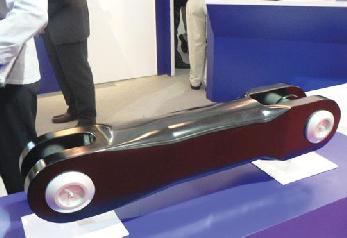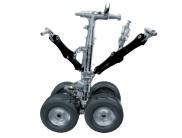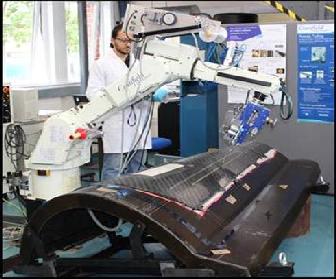Composite landing gear brace for Boeing 787 Dreamliner – first in the market for Messier-Bugatti-Dowty
Submitting Institution
Cranfield UniversityUnit of Assessment
Aeronautical, Mechanical, Chemical and Manufacturing EngineeringSummary Impact Type
TechnologicalResearch Subject Area(s)
Engineering: Aerospace Engineering, Civil Engineering, Materials Engineering
Summary of the impact
Components built using 3D composite manufacturing methods developed by
Cranfield are now flying on the Boeing 787 Dreamliner aircraft. This is
the first use of structural composites in commercial aircraft landing
gear. The prototypes were assembled and reinforced using robot automated
technology developed at Cranfield.
Cranfield's work has extended the use of composite materials into
critical landing-gear systems, allowing Messier-Bugatti-Dowty to
contribute to the use of 50% composite materials for the airframe of the
new 787, delivering weight reduction and better fuel economy.
Underpinning research
Cranfield created a fibre tufting unit in 2003 [G1]. It used an
industrial sewing head to create 3D (z-direction) reinforcement in
addition to the traditional layers and winding, to improve shear and
delamination resistance. In 2005, an interface between a robot and the
tufting tool was added, along with the software routines enabling its
practical use for composite preform reinforcement.
Cranfield had investigated stitching of dry preform plies in the previous
decades. However, at the beginning of this century there was no systematic
research work dedicated to tufting as a method for reinforcing composites,
through-thickness. Cranfield published the outcome of the initial work in
2007 in the first two papers dedicated to this technology [P1, 2].
In 2006 Boeing wanted to replace a heavy metal structure with a lighter
composite alternative. The objective was to meet the stringent performance
requirement for a structure that would be used within the 787 Dreamliner's
landing gear. When Aircelle and Messier-Bugatti-Dowty (MBD), parts of the
Safran aerospace group, approached Cranfield, tufting capabilities were
limited to processing flat preforms that inserted glass fibre or aramid
thread tufts through relatively small thicknesses of material (up to
38mm). Nevertheless, the specifics of the component made it impossible for
the through-thickness reinforcement to be carried out with any other form
of stitching apart from tufting. Aircelle wanted to use a carbon-fibre
thread to form tuft loops fully embedded within the thick shaft of a 1.2m
long brace with large lugs at each end. Cranfield therefore embarked on a
research programme to investigate the potential for tufting using carbon
fibre threads. Our research met these requirements, demonstrating the
improvement in terms of delamination resistance provided by tufting [P3,
6].
 Figure 1: Tufted composite brace, 1.2m long, exhibited at the
Farnborough Air Show (September 2012)
Figure 1: Tufted composite brace, 1.2m long, exhibited at the
Farnborough Air Show (September 2012)
http://www.compositesworld.com/articles/2008-farnborough-airshow-report
(accessed 20/11/13)
Cranfield's researchers tackled several challenges, starting with the
requirement to use a carbon fibre thread which, at the time, was not
readily available on the market. All available grades were too brittle to
withstand needle penetration through tight preforms. The size and shape of
the preform and the particular material combination of the part demanded
novel customised hardware arrangements for the tufting unit, as well as
the development of dedicated controlling routines.
We identified an innovative carbon-fibre thread (at the time still under
development by Toho Tenax) and acquired and successfully tested the
material on Cranfield's tufting system. Cranfield undertook innovative
modifications to the robot setup to accommodate the large preform and
developed the routines to enable tufts insertion on complex double
curvature surfaces. These developments were based on Cranfield's
exploratory research on the feasibility of the technology [P1] and its
optimal utilisation for enhancing mechanical performance [P2]. The
prototypes were impregnated with thermoset resin after tufting and
mechanically assessed by Aircelle. The company now produces carbon fibre
braces reinforced by tufting with carbon thread (figure 1) in its premises
with a newly acquired twin-robot tufting cell. These landing gear systems
have been flying on the Boeing 787 Dreamliner since its maiden flight in
2010.
| Key Researcher |
Post details |
Dates involved |
Research |
| Dr. G. Dell’ Anno |
Academic Fellow |
2004-2013 |
Manufacturing, Mechanical performance, Process monitoring [G4, P1, P2, P4] |
| Prof. I.K Partridge |
Professor, |
2003-2012 |
Manufacturing, Mechanical performance G1, G3, G4, G5, P1, P2, P4] |
| Dr D. D. R. Cartie |
Academic Fellow |
2003-2009 |
Manufacturing, Mechanical performance G1, G3, P1, P2] |
| Prof. R. P. Tatam |
Professor |
2009-present |
Optical fiber techniques for process monitoring [P4] |
| Prof. A. K. Pickett |
Professor |
2005-2006 |
Mechanical performance [G2, P3] |
| Dr A. A. Skordos |
Lecturer |
2006-present |
Manufacturing, Mechanical performance, Modelling [G2, G5 P3, P5, P6] |
References to the research
Evidence of quality — peer-reviewed journal papers
P1* Cartié DDR, Dell'Anno G, Poulin E and Partridge IK. 3D reinforcement
of stiffener-to-skin T-joint by Z-pinning and tufting. Engineering
Fracture Mechanics, 73, pp. 2532-2540, 2006. doi:
10.1016/j.engfracmech.2006.06.012.
P2* Dell'Anno G, Cartié DDR, Partridge IK and Rezai Aa.
"Exploring mechanical property balance in tufted carbon fabric/epoxy
composites". Composites Part A: Applied Science and Manufacturing,
38, pp. 2366-2373, 2007. doi: 10.1016/j.compositesa.2007.06.004
P3* Colin de Verdiere M, Pickett AK, Skordos AA and Witzel Vb.
Evaluation of the mechanical and damage behaviour of tufted non crimped
fabric composites using full field measurements. Composites Science
and Technology, 69(2) pp131-138, 2009. doi:
10.1016/j.compscitech.2008.08.025.
P4 Dell'Anno G, Partridge IK, Cartié DDR, Hamlyn Ac, Chehura
E, James SW and Tatam RP. "Automated manufacture of 3D reinforced
aerospace composite structures". International Journal of Structural
Integrity, 3, (1), pp. 22-40, 2012. doi:
10.1108/17579861211209975
P5 Colin de Verdiere M, Skordos AA, May M and Walton AC. "Influence of
loading rate on the delamination response of untufted and tufted carbon
epoxy non-crimp fabric composites: Mode I". Engineering Fracture
Mechanics, 96, pp. 11-25, 2012.
doi: 10.1016/j.engfracmech.2012.05.01
P6 Colin de Verdiere M, Skordos AA, Walton AC and May M. "Influence of
loading rate on the delamination response of untufted and tufted carbon
epoxy non-crimp fabric composites: Mode II", Engineering Fracture
Mechanics (2012), 96, pp 1-10.
doi: 10.1016/j.engfracmech.2011.12.011
*: 3 identified references that best indicate the quality of the research
a BAE Systems, Advanced Technology Centre, Filton, Bristol
BS34 7QW, UK
b Institute of Aircraft Design, University of Stuttgart
Pfaffenwaldring 31, D-70569 Stuttgart, Germany
c Coriolis Composites, Rue Condorcet 56530 Quéven, France
Further evidence of quality — underpinning research grants
G1 Robotic tufting & Resin Transfer Moulding, £118,300, 2004-2007, PI
Prof IK Partridge, sub project within Cranfield IMRC, EPSRC GR/R68139/01.
G2 EU-FP6 (EU-516146), Integrated tool for simulation of textile
composites (ITOOL), €180,000, 03/2005-09/2008, PI Prof. AK Pickett, CI Dr
AA Skordos
G3 EPSRC (EP/F037937/1), Failure in Tufted Composite Structures,
£153,700, 01/2008-01/2011, PI Prof IK Partridge, CI Dr DDR Cartie
G4 Moving tufting from laboratory into industry, £68,000, 2011, PI Prof
IK Partridge, sub project within Cranfield IMRC, EPSRC EP/E001874/1.
G5 EU-FP7 (EU-234290), Advanced integrated composite tail cone (ADVITAC),
€1,000,000 05/2009-07/2013, PIs A Skordos, Prof R P Tatam; CIs Prof. IK
Partridge, Dr S W James
Details of the impact
Composites are now widely used in aircraft — the Boeing 787 Dreamliner
uses 50% composites [C1]. The tufted composite braces, based on
technologies developed at Cranfield, are the first use of structural
composites in the landing gear of a commercial aircraft (figure 2). The
use of Cranfield's tufting technology to assemble and reinforce the
sub-components of the 3D woven preform has enabled Aircelle and MBD to
achieve their goals in terms of material performance [C2, 7].
 Figure 2: Detail of the landing gear of the Boeing 787 (the composite
braces are shown in black).
Figure 2: Detail of the landing gear of the Boeing 787 (the composite
braces are shown in black).
The advantages of composites over the traditional steel components are:
weight saving due to improved strength-to-weight ratio of the constituent
material, which become significant considering that each Boeing 787 is
equipped with eight such braces; higher resistance to corrosion, reducing
maintenance work and servicing costs; higher resistance to fatigue;
greater in-service reliability; and longer service time between overhauls.
Ultimately the weight saving gives benefits in reduced fuel burn and CO2
emissions, and better competitiveness for the manufacturer.
A traditional laminated composite could not bear the complex axial and
shear loading pattern expected in such a critical structure, or withstand
impact from potential bird strikes or debris flying from a runway. The
adoption of a composite structure with a 3D fibre architecture was,
therefore, an essential requirement in the material selection for the
composite brace.
Three-dimensional weaving technologies allow the production of preforms
with fibres arranged along three main directions, however, complex shapes
are difficult to produce in a single step. The preform for the brace had
to be manufactured as two subcomponents, subsequently tufted together. The
option of using tufting within such an innovative manufacturing process
had never been attempted before. Cranfield had to conduct several
preliminary trials and tests on simple preforms to assess the tufting unit
ability to produce the required result. (Figure 3 shows an example of the
use of tufting in a complex aerospace component.)
 Figure 3: Tufting robot at Cranfield inserting tufts in a
double-curvature surface.
Figure 3: Tufting robot at Cranfield inserting tufts in a
double-curvature surface.
The preformed part was manufactured at Aircelle as two subsections of 3D
woven carbon-fibre tows around a core of aluminium honeycomb. However, the
designers required extra fibre reinforcement to be inserted
through-the-thickness of the preform to join the two subsections and to
enhance its damage tolerance. Cranfield's research showed that it could
meet these requirements, demonstrating the improvement in terms of
delamination resistance provided by tufting. This was established with the
investigation of the influence of tufting incorporation on interlaminar
behaviour, showing improvements in delamination toughness in the range of
60%-400%, whilst preserving in-plane properties, and the development of
validated predictive models enabling consideration of property
modification to be integrated within the design phase [C6].
The prototypes have gone into full production by Messier-Bugatti-Dowty
and are currently flying on the world's fleet of Boeing 787s [C7]. The
value to business can be appreciated by considering that landing gear
typically comprises 2% of the cost of wide body jets. The price of the 787
is estimated at $200M and the current (2013) cumulative orders are circa
930 aircraft. The contract to supply Boeing Commercial aircraft was a
first for Safran / Messier-Bugatti-Dowty and secures workshare for up to
20 years. The extensive use of composite materials for the airframe of
this the new aircraft has brought benefits of weight reduction and
consequent fuel economy. The Cranfield work has now extended the use of
these materials into critical landing gear systems giving Messier-
Bugatti-Dowty access to similar weight reducing advantages to their
products [C3-5, 7].
Sources to corroborate the impact
C1 787 Dreamliner program fact sheet
http://www.boeing.com/boeing/commercial/787family/programfacts.page
C2 Leung E. "The Development and Certification of Composite Landing Gear
Components for the Boeing 787". Messier-Bugatti-Dowty presentation at
SAMPE UK Seminar, 27 February 2013 http://sampe.org.uk/assets/pdfs/SAMPE2013AGM/MessierDowtyInc-SAMPEUK2013.pdf
(last accessed 10/2013)
C3 "First 787 landing with Messier-Dowty composite landing gear braces"
Messier-Bugatti-Dowty press release, URL: www.safranmbd.com/actualites/actu-et-communiques-de-presse/article/first-787-landing-with-messier
(last accessed 04/2013)
C4 "Boeing 787 Dreamliner" Messier-Bugatti-Dowty press release, URL:
www.safranmbd.com/leader-mondial/programmes-majeurs/article/boeing-787-dreamliner
(last accessed 04/2013)
C5 "Boeing 787: Composites make a successful landing" Safran press
release, URL: www.safran-group.com/site-safran-en/press-media/media-section/article/boeing-787-composites-make-a?10605
(last accessed 04/2013)
C6 Contact: Resin Transfer Moulding engineering manager, Aircelle Le
Havre
C7 Contact: Chief Engineer (PCE), Messier-Dowty Inc, Canada